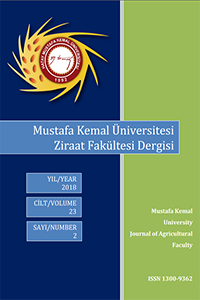Öz
Taban suyunun bitki kök bölgesinde yükselmesi,
tarımsal üretimin azalmasına neden olur. Verimin azalması yanında, tuzluluk ve
sodyumluluk gibi problemlerinde ortaya çıkmasına neden olabilir. Sulama
amacıyla yapılan yatırımlardan beklenen yararın sağlanabilmesi için, taban
suyunun sürekli izlenmesi ve projelerde öngörülen düzeylerde tutulması
gerekmektedir. Bu çalışmada Hatay Kırıkhan ilçesinde koordinatları bilinen 60
gözlem kuyusunda 2004 yılından 2016 yılına kadar Devlet Su İşleri (DSİ)
tarafından yapılmış taban suyu derinlik ölçüm değerleri kullanılmıştır. 2004,
2008, 2012 ve 2016 yılları sulamanın en yoğun olduğu temmuz ayı için taban suyu
eş derinlik haritaları hazırlanmış, taban suyu derinliğindeki değişimler,
farklı yıllar için ILWIS CBS ile incelenmiştir. Taban suyu derinliklerindeki
alansal değişimler, şebekeye alınan sulama suyu miktarları ile kıyaslanarak
kullanılan sulama suyu miktarının taban suyu derinliğine etkisi
araştırılmıştır. Sonuç olarak, taban suyu derinliği ile şebekeye alınan sulama
suyu miktarı arasında önemli bir ilişki bulunmuştur, planlı su dağıtımı ve
uygulaması ile taban suyu seviyesinin kontrol edilebileceği sonucuna varmıştır.
Anahtar Kelimeler
Kaynakça
- Referans 1 Ahmad M, Arshad M, Iqbal M, Waqas MM, Awais M, 2017. Simulation of groundwater quantity using hydrological model for Mithawan spate irrigated area of Dera Ghazi Khan, Pakistan, Pakistan Journal of Agricultural Sciences, 54: 847-853.
- Referans 2 Cemek B, Demir Y, Erşahin S, Arslan H, Güler M, 2006. Spatial variability of groundwater depth, soil salinity in irrigated soils of Bafra plain in northern Turkey. International Symposium on Water and Land Management for Sustainable Irrigated Agriculture, Adana, Turkey.
- Referans 3 Jin Y, He R, Marino G, Whitting M, Kent E, Sanden BL, Culumber M, Ferguson L, Little C, Grattan S, Paw KT, Lagos L O, Synder RL, Zaccaria D, 2018. Spatially variable evapotranspiration over salt affected pistachio orchards analyzed with satellite remote sensing estimates. Agricultural and Forest Meteorology,262: 178-191.
- Referans 4 Machiwal D, Mishra A, Jha MK, Sharma A, Sissodia SS, 2012. Modeling short-term spatial and temporal variability of groundwater level using geostatistics and GIS, Natural Resources Research, 21: 117-136.
- Referans 5 Mazzei V, Gaiser EE, Kominoski JS, Wilson BJ, Servais S, Bauman L, Davis SE, Kelly S, Sklar FH, Rudnick DT, Stachelek J, Troxler TG, 2018. Functional and compositional responses of periphyton mats to simulated saltwater intrusion in the southern Everglades, Estuaries and Coasts, 41:2105-2119.
Öz
The rise of the groundwater in the plant root zone causes the decrease in agricultural production. In addition to the decrease in yield, it can cause problems such as salinity and sodication. To achieve the expected benefit from investments made for irrigation purposes, groundwater should be continuously monitored and maintained at the levels foreseen in the projects. In this study, the depth of the groundwater measured by DSİ was used in 60 observation wells known as coordinates in Hatay Kırıkhan district from 2004 to 2016. In 2004, 2008, 2012 and 2016, groundwater contour maps were prepared for July when the irrigation is the most intensive period, and changes in groundwater depth investigated with ILWIS GIS software. Fluctuates in groundwater depths were compared with the amount of irrigation water taken into the network and the effect of the amount of irrigation water used on the depth of the groundwater was investigated. As a result, an important relationship was found between the depth of groundwater and the amount of irrigation water received to the network, and it was concluded that planned water distribution and application could control the groundwater level.
Anahtar Kelimeler
Kaynakça
- Referans 1 Ahmad M, Arshad M, Iqbal M, Waqas MM, Awais M, 2017. Simulation of groundwater quantity using hydrological model for Mithawan spate irrigated area of Dera Ghazi Khan, Pakistan, Pakistan Journal of Agricultural Sciences, 54: 847-853.
- Referans 2 Cemek B, Demir Y, Erşahin S, Arslan H, Güler M, 2006. Spatial variability of groundwater depth, soil salinity in irrigated soils of Bafra plain in northern Turkey. International Symposium on Water and Land Management for Sustainable Irrigated Agriculture, Adana, Turkey.
- Referans 3 Jin Y, He R, Marino G, Whitting M, Kent E, Sanden BL, Culumber M, Ferguson L, Little C, Grattan S, Paw KT, Lagos L O, Synder RL, Zaccaria D, 2018. Spatially variable evapotranspiration over salt affected pistachio orchards analyzed with satellite remote sensing estimates. Agricultural and Forest Meteorology,262: 178-191.
- Referans 4 Machiwal D, Mishra A, Jha MK, Sharma A, Sissodia SS, 2012. Modeling short-term spatial and temporal variability of groundwater level using geostatistics and GIS, Natural Resources Research, 21: 117-136.
- Referans 5 Mazzei V, Gaiser EE, Kominoski JS, Wilson BJ, Servais S, Bauman L, Davis SE, Kelly S, Sklar FH, Rudnick DT, Stachelek J, Troxler TG, 2018. Functional and compositional responses of periphyton mats to simulated saltwater intrusion in the southern Everglades, Estuaries and Coasts, 41:2105-2119.
Ayrıntılar
| Birincil Dil | Türkçe |
|---|---|
| Bölüm | Araştırma Makalesi |
| Yazarlar | |
| Yayımlanma Tarihi | 25 Aralık 2018 |
| Yayımlandığı Sayı | Yıl 2018 Cilt: 23 Sayı: 2 |

